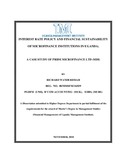| dc.description.abstract | PRIDE Microfinance Ltd had experienced low profitability for the period 2004 – 08,
with remarkable loss of UGX 0.7 billion in 2006 where interest income earned barely covered
all aggregated costs. The researcher conceived that interest rate policy from which interest
income was derived affected financial sustainability of PML, which prompted the study to
establish the relationship between interest rate policy (IRP) and financial sustainability (FS) of
PRIDE Microfinance Ltd (PML). The IRP was conceptualised as the independent variable,
financial sustainability as the dependent variable, clients’ response as the moderating variable
and operational grants, subsidies … and Treasury bill interest income as the intervening
variables. The objectives of the study were to establish the effects of interest rate
determination policy, interest rate application methods, interest income collection methods
and the moderating influence of client’s response to the interest rate policy on the relationship
between interest rate policy and financial sustainability. The case study design used a
quantitative approach integrated with qualitative aspect with a sample of 89 respondents out of
a study population of 149 elements using census, purposive sampling, random and systematic
random sampling techniques. Data was collected using questionnaires, an interview guide, and
documentary review and observation checklists and were analysed using Pearson correlation,
Part and partial correlation and a hierarchical multiple regressions with the aid of SPSS. The
results were used to answer the research questions and testing hypotheses.
With the part correlation result r1 = 0.880, sig. 0.000, it was found that the interest rate
policy had a very strong, positive linear relationship and significantly accounted for 77.4% of
financial sustainability. The interest rate determination policy with Pearson correlation, r =
0.685**, sig. 0.002, had a positive linear relationship and accounted for 47 % variations in
financial sustainability. The interest rate application methods with Pearson correlation, r =
0.864**, sig. 0.000, had a very strong positive linear relationship and significantly accounted
for 75% variations on financial sustainability, where by the flat rate application method
negatively affected while the reducing balance method positively improved financial
sustainability respectively. The interest income collection methods with Pearson correlation, r
= 0.833**, sig. = 0.000 had a very strong positive linear relationship and significantly
explained 70% variations in financial sustainability while clients’ response to interest rate
policy, with part and partial correlation reducing from r1 = 0.880** to r2 = 0.876**, sig. 0.000,
was found to have a negative influence on the relationship between interest rate policy and
financial sustainability at 99% significance level. Financial sustainability was low when the
interest rate policy was neither in place nor tailored, but when the interest rate policy was in
place and implemented, financial sustainability improved. Financial sustainability reduced
when client’s response to interest rate policy was exhibited.
The study recommended a fully documented interest rate policy for PML. The interest
rate determination policy should specify composition rates; Administrative expense rate, loan
loss provision rate, cost of funds rate and Capitalisation rate and the interest rate charged
should be revised periodically to suit financial sustainability. The study further recommended
the declining balance method as the interest rate application method to be implemented for
PML to improve financial sustainability. The study recommended the interest income due,
interest income paid and zero arrears tolerance policies in the interest income collection
methods and finally, client’s awareness on the rationale of interest rate policy and a study on
client’s sensitivity to interest rate in PML should be undertaken. Those recommendations once
implemented will enable PML to achieve financial sustainability. | en_US |

